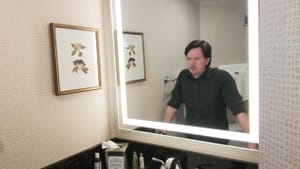Stay in the Loop
BSR publishes on a weekly schedule, with an email newsletter every Wednesday and Thursday morning. There’s no paywall, and subscribing is always free.
A theatrical check-in
Philly Fringe 2020: Die-Cast presents ‘Temporary Occupancy’

For many of us, it’s been at least six months since we’ve been on the road long enough to need a hotel room. So the first look at the videos that make up part of Die-Cast’s Temporary Occupancy, now live for Fringe audiences in Philly, bring a weird gust of nostalgia—not for a familiar place (though if you’ve seen one budget hotel room, you’ve seen them all), but for a time when landing in another city for the night was no big deal.
That change of scene, and its invitation to imagine other lives, is part of what pandemic-era theater is offering us. As the Die-Cast ensemble plays out realistic, understated yet high-stakes vignettes inside a real hotel room, the show succeeds.
Welcome to the “show”
Temporary Occupancy was originally destined for live performances in a Miami Beach hotel earlier this year, but when COVID scuttled that, Die-Cast partnered with Seattle’s ArtsWest Playhouse (Die-Cast cofounder Brenna Geffers connected with her friend, former Philly colleague, and ArtsWest artistic director Mat Wright), and premiered the show in August for audiences there. Now it’s live for Philly viewers.
“Show” might not be the right word for most 2020 Fringe offerings, which are a wide range of interdisciplinary, mostly digital and/or remote experiences that incorporate some element of scripted or choreographed performance. Temporary Occupancy ticket buyers receive a link to a website for a travel company called Vicurious, featuring photos of opulent, anonymous hotel spaces.
“Our boutique encounters allow for emotional cleansing without the physical risk of being around others as well as the psychological risk of personal trauma,” the site’s welcome promises.
Through interactive nudges, visitors explore Vicurious, including a “reservation assessment” before your visit, to “confirm that you are in an emotionally stable place,” though I’m not sure who among us can meet that criteria half a year into the pandemic.
The occupants
Many of the characters who appear in these stories are navigating quarantine life just like we are—they aren’t in a COVID-free alternate universe. They leave home for the same reasons we might: a tryst, a job, news to deliver. It’s best to meet these stories without knowing too much. A man faces making a personal revelation; a couple reunites after a long spell of quarantine; a business trip goes awry; a parent figure longs to connect with a child. Masked strangers in a hotel hallway perform an elaborately uncomfortable duet that will feel familiar to anyone who’s tried to keep their distance from other people in the grocery aisles.
Each vignette arrives in its own way. One takes place in a mirror. Others give the audience different windows to peer through—a Zoom call, FaceTime, a video the characters make themselves. Nowadays, there are so many ways to witness each other at a distance.
How did we get here?
This raises interesting questions about how we approach the theatergoing experience, now that artists have to work beyond the stage and audience. Walking into the house with your playbill, finding your seat, waiting for the lights to dim—these are all rituals preparatory not just to watching a show, but to suspending disbelief: entering the small universe in front of you that you know the artists have created. Now, a lot of theater has been adapted to experience as a video stream. What makes it theater, and not a film?
Without being able to walk into the audience and turn our eyes to the stage, we approach the work with implicit, perhaps unconscious questions that we rarely bring to a movie or TV show. How did I get here? Where and how and why am I witnessing this? COVID-age shows like Temporary Occupancy involve us in these questions as well as telling a story.
Image description: A mirror’s reflection in a hotel bathroom shows a man, in a dark button-up shirt, with a worried expression.
What, When, Where
Temporary Occupancy. By Die-Cast, for the 2020 Philadelphia Fringe. Through October 4, 2020. More info at the FringeArts website.
Sign up for our newsletter
All of the week's new articles, all in one place. Sign up for the free weekly BSR newsletters, and don't miss a conversation.

 Alaina Johns
Alaina Johns